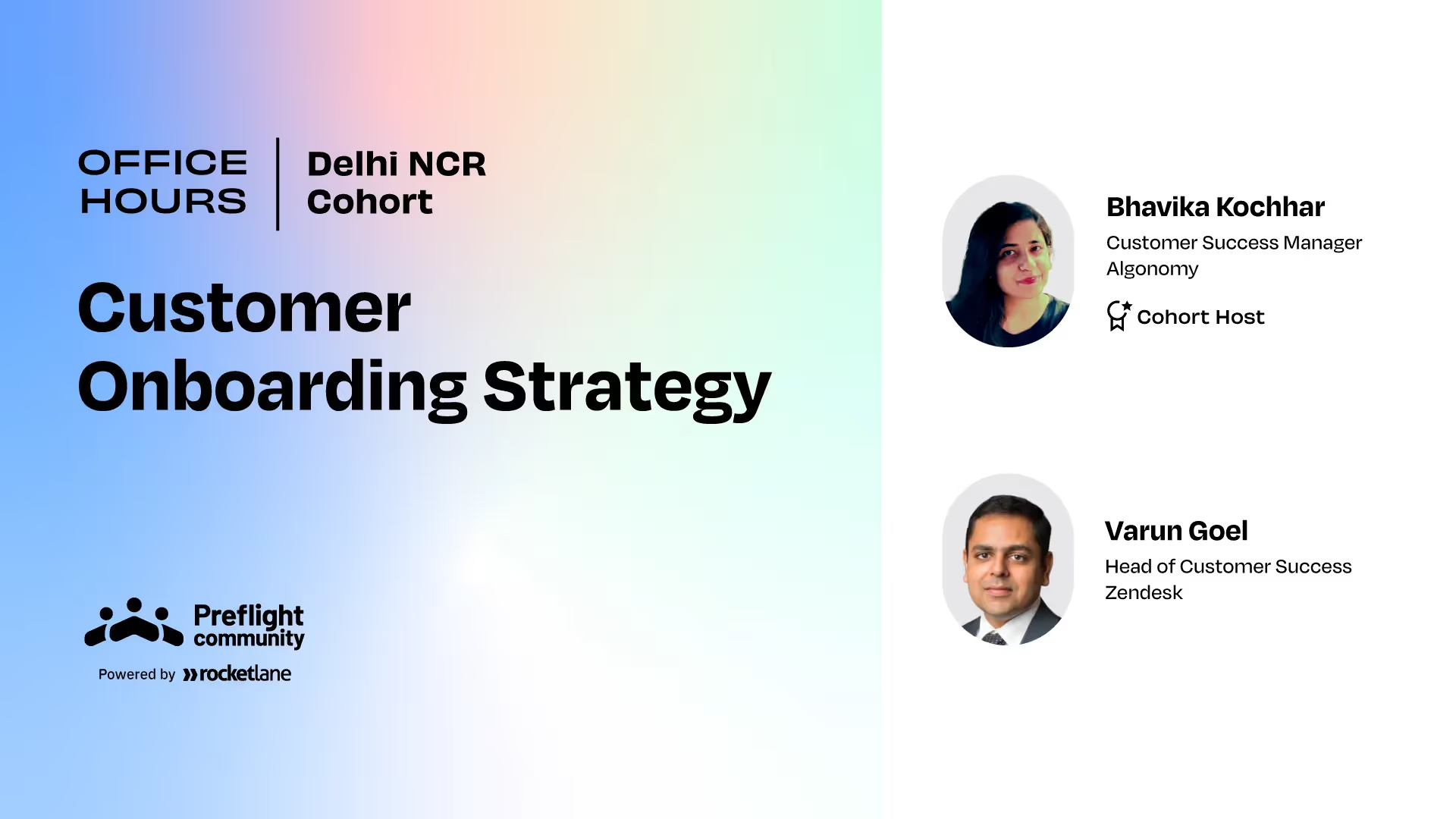In this session of Office Hours for Preflight's Delhi Cohort, Varun Goel, Head of CS at Zendesk spoke to Cohort Host Bhavika Kochhar to share his learnings on customer onboarding strategy.
In his career so far, Varun has built and led highly efficient and diverse functions from engineering, quality assurance, and product management to key account management, digital marketing, and employee experience.
At Zendesk, Varun is responsible for managing and developing Zendesk’s existing customer base with a focus on enterprise customers. He helps customers realize maximum business value across the customer lifecycle, resulting in improved customer satisfaction, renewal, and growth of lifetime value.
In this session, Varun spoke about:
- The role of customer education and experience in customer success
- How companies can set the right vision and strategy for customer onboarding
- The types of onboarding
- Creating the right onboarding workflows, and more.
Here are our 10 top takeaways from the session.
1. Customers buy experiences, not products
Building a great customer experience is not easy, no matter how great the product is. It needs the right leader and thought leadership, investment, team, resources, systems, and tools. Great customer experience depends on multiple teams (CS, Onboarding/Implementation/Professional Services, Product) working together to deliver effective education and onboarding for customers.
2. Customer Onboarding is crucial to value realization
Onboarding acts as the bridge between the sales journey and the value realization journey. Onboarding teams need to remember how important they are at the start of the value realization journey and how important customer education is.
3. You need to nail the Sales-to-CS handoff
Whether it is the onboarding team or the CS team that steps in right after the sale, the sales handoff should include the following details:
- Use cases sold to the customers
- Customer POCs and influencers
- Customer’s implementation team, their current capabilities, and the level of support they’d need
4. Manage the time gap between sales and value delivery
The typical timeline for approaching the onboarding team after the sale closure is 2-3 days. If customers ghost or go cold, involve Sales without losing any time.
5. Understand the sub-types of customer onboarding
Though customer onboarding varies from company to company, broadly, it includes the following elements:
- Product and customer onboarding apply to customers signing up to use the product for the first time.
- Account onboarding is where the leadership has a big role to play. The key exercise at this stage is identifying the KPIs that can be set for the customer (based on benchmarks from other customers) and helping them understand the outcomes they can achieve.
- Feature onboarding and ongoing engagement are designed to help existing customers dive deeper and use features they can benefit from.
- Feature onboarding typically begins 2-3 months after the sale. It’s important to involve the product team at this stage to understand the product roadmap, what features it includes, and evaluate if and how they can help the customer. Feature onboarding is typically handled by CS after customizing it to their customer accounts, though in some cases, this is handled by the onboarding team.
6. Poor customer onboarding experiences lead to low adoption
Onboarding experiences typically include multiple touchpoints:
- Trial
- Emails
- Product tours
- Help docs
- Training
- Community
- Developer docs
- Advocacy
- Success Kickoffs
- Sales
This leads to confused admins and lower adoption at the customer end. Here’s how:
- Multiple learning options and messages provided by multiple teams leads to a disjointed experience
- There is confusion about where to access help and how
- Contextual guidance for features is insufficient, leading to a lack of engagement and adoption
- The customer experience is not personalized, making the customers feel the product doesn’t meet their needs
This is why designing your onboarding strategy based on an overarching vision/goal is critical to ensure customers derive value from the product.
7. Have a clear customer onboarding strategy
Enable customers to unlock the value your company brings to their business with a curated onboarding experience that is unified across touchpoints.
The three principles that anchor customer onboarding:
- Get customers to use the product at least once a week
- Study the usage and map them against the KPIs on an ongoing basis
- Do what it takes to make your product indispensable
Here are the key things to focus on in your onboarding strategy:
- Leveraging product and experience as the primary vehicle to drive the onboarding journey complemented by other touchpoints
- Building task-based, guided pathways to get customers up-and-running quickly
- Personalizing experience based on customer intent
- Surfacing contextual resources based on best practices and product usage
- Improving ease of use and minimizing friction during initial product setup
- Establishing governance to ensure customer touchpoints connect into a consistent and cohesive journey
8. Key elements to executing a customer onboarding strategy
Here’s what it takes to nail your customer onboarding strategy:
- The right leadership and building alignment across the team
- Prioritization and accountability: Customer onboarding needs to be a priority with a POC accountable for it from every team (CS, Product, Advocacy, Marketing, etc.)
- Funding: Executing a customer onboarding strategy needs an investment in resources (say for program management), systems, and the right teams.
9. Include these elements in a customer onboarding checklist
- Automated emails to welcome new customers
- Content for specific areas/ touchpoints
- Regular check-ins (or a mechanism) for reporting
10. Have a purpose-built onboarding strategy for enterprise customers
The gestation period varies for complex products. If a partner is involved in implementation, it helps to account for a buffer period to fill any education gaps in their understanding and bring them up to speed. If the model involves customers doing implementation themselves, make sure to check if they have the right technical skills to do it.
11. Have a strategy to manage adoption challenges caused by disengaged end users
Since end users are not the ones who made the purchase decision, there is often an awareness and motivation gap that impacts adoption.
- The key is to hold the customer leadership accountable for communicating the change to the end-user right at the start, and ensuring that end-users are engaged and involved
- Use the first onboarding call to engage the Sales team at your end and the Solution Consultant and leadership from the customer’s end to (a) Identify the key people, stakeholders, and end-users (b) Insist on a communication plan that the leadership will use to inform and involve end-users, and (c) Involve a few end users on the first call
- Don’t wait till the EBR/QBR to raise issues, instead raise issues with the leadership team as and when they arise.
If you want to learn more about Customer Onboarding, Implementation, and Professional Services in-depth, join the Preflight Community.

























.webp)